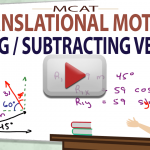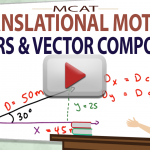The MCAT will test your ability to analyze single vectors, as well as solving larger problems combining 2 or more vectors. While the math for adding and subtracting vectors isn’t difficult, it’s important to understand the nature of each vector combination and the logic behind the specific equations used. The video below shows you how […]
Adding Two Dimensional MCAT Vectors Using Angles and Vector Components Translational Motion Video 4
This video picks up from Part 3 where we discussed adding and subtracting vectors when facing in the same and opposite directions. But the MCAT is designed to be tricky, and so you will likely find yourself faced with a problem combining vectors at some odd angle off the x-axis or y-axis. This video shows […]
Vectors and Vector Components in MCAT Translational Motion Video 2
As you are reviewing your general physics concepts for the MCAT you will come across practice questions utilizing 1, 2, or 3 dimensions. While the MCAT only tests on single and two-dimensional problems, you will often find yourself faced with a vector situated between the x and y axis. However, some of the required calculations, […]
Introduction to Translational Motion in MCAT Physics
The topic of translational motion and standard kinematics may very well be one of the most important concepts to cover in your MCAT physical sciences preparations. As you work through the different topics in physics you will find yourself returning to these equations again and again. Given how important this is, I recommend that you […]






